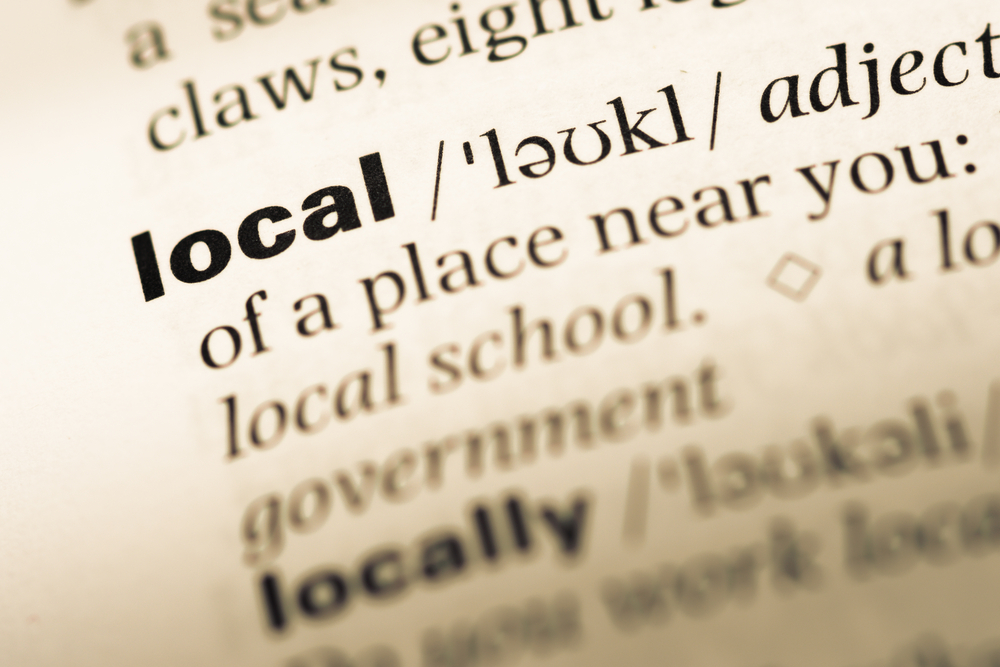
I was in an Uber last week in Madison. After the driver suggested I might enjoy driving for the company when I retire (!), he asked me questions about exactly what a radio consultant does.
I started talking about the usual descriptors – helping radio companies grow their ratings and revenue. But then I pivoted to what I think is a better way to frame out what I do. And it often comes down to this:
It’s about trendspotting.
As I’ve talked about in recent days, going to CES is a fertile setting for identifying trends in technology, and how they might affect broadcasters. But most of the time, it involves connecting the dots right in front of me – the research we conduct or I’m privy to, reading as much as I can, scouring social media, and the discussions with people in my orbit with the ability to synthesize what’s going on around them.
None of it is an exact science, of course. But there are times when you see pieces of “evidence” from multiple sources, and the tumblers just click.
For those of you who regularly read this blog, today’s topic comes as no surprise. I’ve been writing about it with purpose since the earliest days of COVID. There are increasing signs that throughout the media world, the move to a “local” emphasis is becoming a consensus strategy.
We’ve seen it clearly in our Techsurveys, especially in public radio. But commercial radio and Christian music radio research is revealing similar indicators. Here’s the key slide in Public Radio Techsurvey 2023. Note the even stronger appeal of local among progressively younger listeners, another consistent theme:
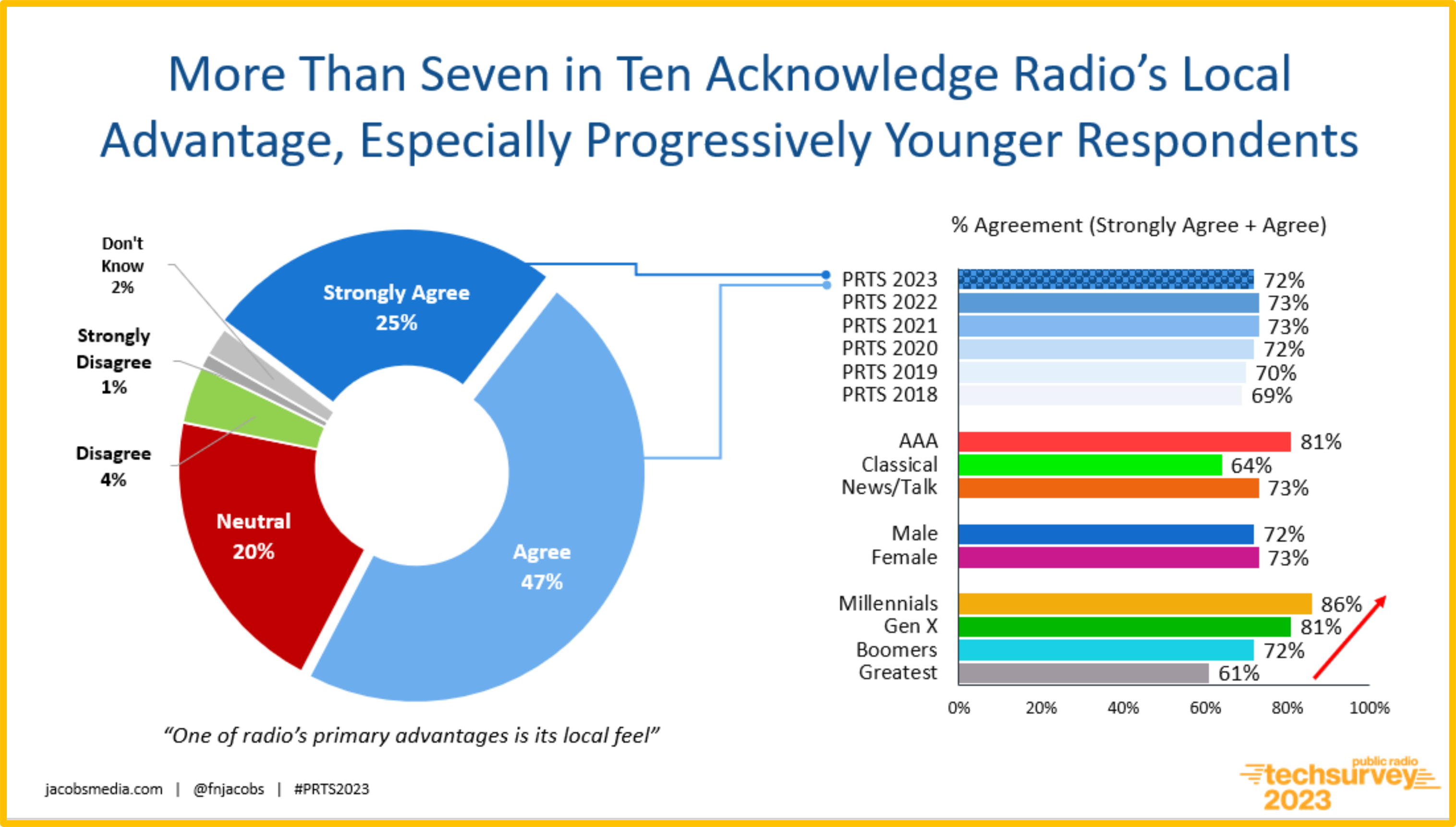
It’s compelling, not just on its face, but because so much programming content on public radio stations is network based. And yet, the audience is pointing in a different direction.
In PRTS, there is also a series of findings that illustrate the types of local coverage public radio fans desire, and how they define what “local” means to them. In anticipation that we’d continue to see this trend in this year’s study, we created a series of questions that provide some details, including the idea listeners would like to see their favorite stations and personalities be more visible in the community.
For example, we learned nearly seven in ten respondents already read newsletters with a local or regional emphasis at least weekly. And six in ten weekly podcast listeners say they’d be interested in listening to a daily local podcast produced by their favorite public radio station, perhaps something like “The Daily,” with coverage of the local or regional environs.
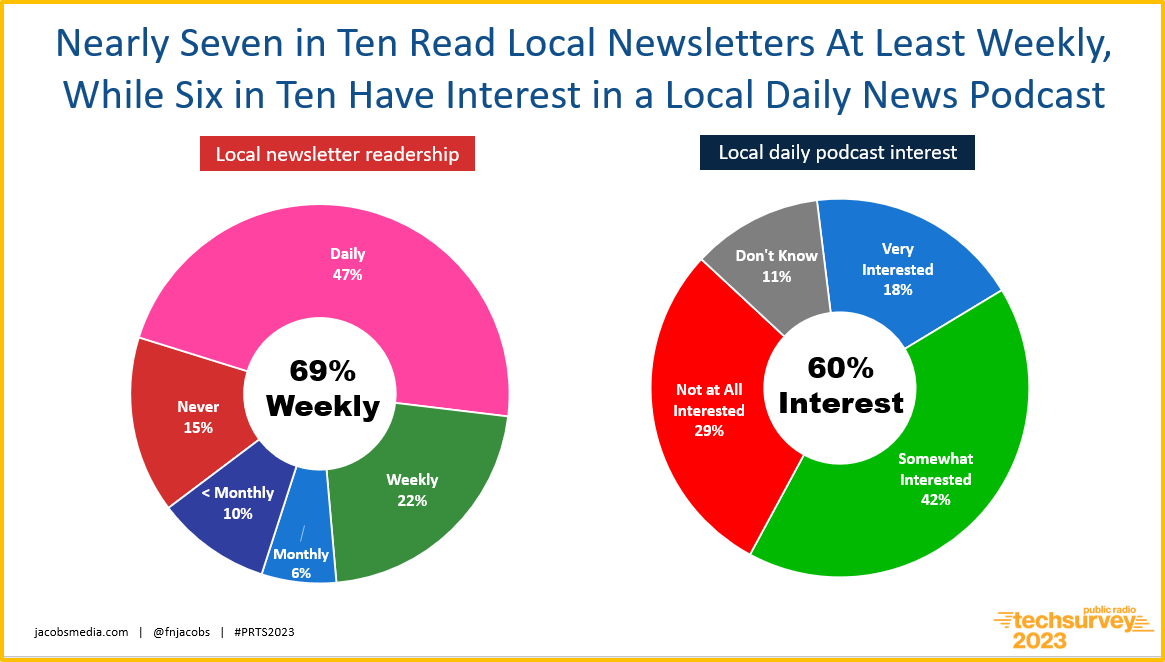
Again, this is more evidence in the growing appetite for more local coverage – on and off the air.
But it gets better. Yesterday, I blogged about an ambitious public radio project that aggregated 26 research studies on behalf of three of public radio’s most influential organizations – SRG, PRPD,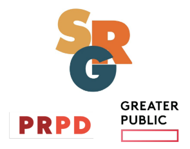 and Greater Public.
and Greater Public.
These projects were originally commissioned for public radio stations of all types from around America. An outside research company, City Square, had the challenging task of analyzing these projects, looking for common threads, tendencies, and possibly trends.
And one that clearly popped is the audience’s interest in news from their cities and towns. Here’s a screen cap of their “Playbook,” designed to give public radio stations an actionable guide:
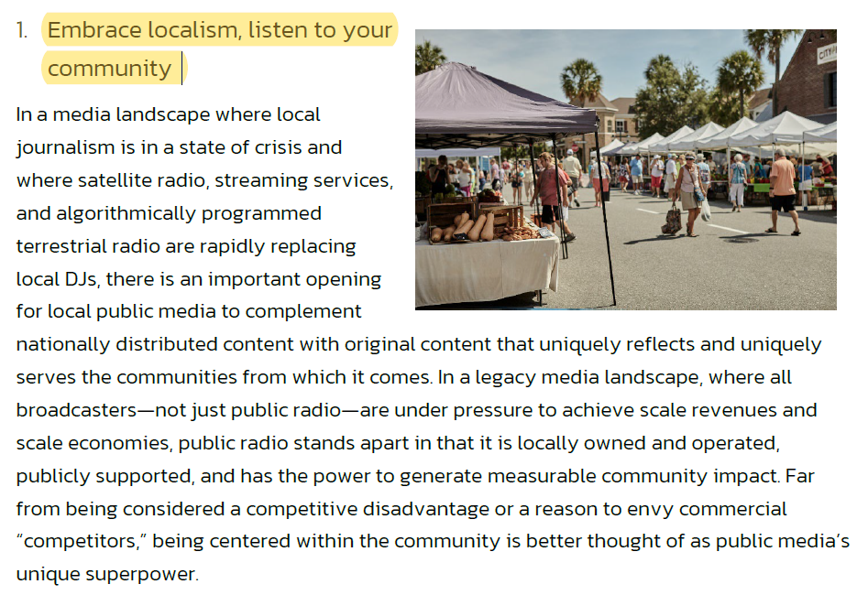
This idea of community focus as a public radio “unique superpower” is somewhat foreign to many public radio news stations, many of whom produce very little local programming of their own. But repeatedly in research conducted across the country, the local opportunity continued to emerge in this City Square analysis.
To add to this narrative, there was a recent opinion piece published by the Washington Post (sorry, it is behind a paywall) fittingly called “The rebirth of local news depends on all of us.” Written by Leonard Downie Jr, a former executive editor of The Post, it’s a thorough look at all the different ways local news is making a comeback, and manifesting itself in different shapes and forms.
Downie has picked up on the obvious trend in local markets all over the country: traditional ad based/subscription dependent newspapers have been “largely destroyed by the digital revolution.” And local TV news stations are often fixated on news stories oozing with crime and violence, very much in the spirit of “if it bleeds, it leads.”
But Downie sees green shoots in many local communities for hometown news coverage. While every market is different, of course, there are many strategies successfully being used in often unpredictable ways.
Among them:
- Nonprofit local news websites – Downie notes these can be small start-ups with lean staffs can be more impactful compared to award-winning newsrooms with a large team of journalists.
- Nonprofit newspapers – Once they were metropolitan newspapers but have been transformed into nonprofits. The Chicago Sun Times was merged with Chicago public radio station, WBEZ. And there are others.
- Family newspaper owners – From Jeff Bezos buying the Washington Post to John W. Henry of the Boston Red Sox buying the Boston Globe a decade ago, this is another key trend to save existing papers while preserving local news coverage.
- University student-produced local news – Downie provides several examples of robust college newspapers providing robust local news coverage. I’ve heard about several of these, including Arizona State’s student-run Cronkite News whose focus is on news from around the state.
- State government support – Downie notes state legislatures are passing bills and establishing programs to support local news coverage. Not surprisingly, UC Berkeley is receiving $25 million to support local reporters.
- Public radio news stations – Yes, it’s gratifying Downie turns to public radio as a beacon of this renewed spirit of local news coverage. He points out that a number of stations have collaborated with NPR on “grant-funded regional reporting partnerships.” And Downie notes how public radio news operations in New York, L.A. and Washington, D.C. have acquired the “ist” local news websites. WNYC/Gothamist, KPCC/LAist, and WAMU/DCist are using these digital news resources to support their local news coverage. These alliances and partnerships are unique for these times. But as Downie’s piece points out, saving local journalism will require creativity and risk-taking.

While WNYC, KPCC, and WAMU are deservedly singled out in this Post piece, public radio observers will readily tell you these examples are too few and far between. The aforementioned City Square research analysis confirms this. In order to optimize their local roots, nonprofit stations will have to find ways to marshal their resources to support what promises to be a greater focus on local and regional journalism in the years ahead.
Of course, this might also take the form of state and regional collectives, where several news operations pool their assets to collaborate on local coverage. Some of this is already happening in states across the country where groups of stations are pooling reporters and news stories.
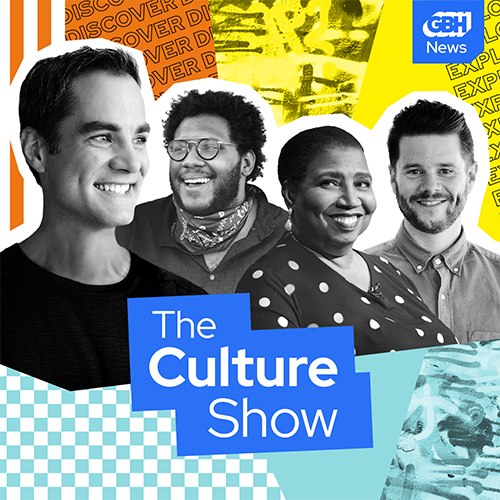
In a story in today’s Radio Ink, WGBH (Boston) is about to launch its first local show in a decade. Not only does this support the larger “local” trend, but it also reinforces the reality that most public radio stations need to bolster – or even start – local programming initiatives.
“The Culture Show” will become a daily offering starting in November, looking to “engage local listeners in a wide array of cultural topics, ranging from music and movies to food and fashion.”
To make the most of this “superpower,” public radio will have to get more creative and innovate their way to success. It will require breaking down their silos, not getting mired by conventional thinking, and being open to new models. And their efforts will have reach beyond news coverage to provide a local sense of place and vibe that has nothing to do with newscasts or documentaries.
The City Square report touches on what this might look like:

It’s about getting out of the studio and making eye contact with the local audience – a repeated desire in most public radio research studies. For many stations, this will be like using muscle memory that’s been dormant for decades.
But it’s essential. The competition is largely national or even global players. And while Axios and others are attempting to establish local bureaus and reporting, most public radio stations have a home field advantage – if they utilize and maximize it.
It’s a similar path many commercial radio stations might consider. That’s because in spite of the trend around national shows and generic programming, commercial stations have similar opportunities – if they’re willing to put in the work, the time, and investment. I know….that’s a big “IF.”
I’ll talk about what that might look like in an upcoming post.
Meantime, next time you bring up the idea of homecooked radio, and a cynic in your company or on social media scoffs, “Local schmocal,” show them this post. Things are changing.
- What To Do If Your Radio Station Goes Through A Midlife Crisis - April 25, 2025
- A 2020 Lesson?It Could All Be Gone In A Flash - April 24, 2025
- How AI Can Give Radio Personalities More…PERSONALITY - April 23, 2025




I retired in March 2022 from a talk radio network position in Washington DC. Uber tried to tempt me too, once I was idle. But no, I joined the staff of a local AMer (with FM translator) that is live during daytime hours and completely local. And everything you say is 1 zillion percent true: local voices and local faces are IT.
We may not have every set of ears around town tuned in, but everyone knows this station.
Timely local content are perhaps the most important elements to distinguish radio from the myriad offerings of other media. Timely means live, or very near live information and response to events happening in the community and beyond. Local content presents topics and issues that directly affect listeners, and are unavailable from national broadcasts. In effect, you’re narrowing your “broadcast” to a specific area in order to serve the public interest, convenience, or necessity. What a quaint idea, huh?
Excellent article Fred. I’m anxious to see your future piece on how commercial radio can do local news in this day and age. There are many judgement calls that go into story selection and presentation of local stories in an effective local newscast. Some of those doing news right now are clueless.
Today’s news staff need consulting from those who learned the craft while attending many NAB and RTNDA conferences decades ago hearing from Bliss, Block, Osgood, Geller and more on solid writing and use of sound to use in telling today’s local news!
Local can be done easily and inexpensively. Hugely more effective on radio than unlicensed podcasting. Thank you, Fred.
“And oftentimes, reaching everyday people does not mean the front page of The Washington Post; instead, it means local news and local radio, and it means empowering local voices.”
That’s from a recent piece that somewhat approaches this from the other end (PR/media relations)–which is much closer to my line of work…
https://www.prnewsonline.com/why-local-journalism-is-key-to-winning-campaigns
Good stuff, Eric. I had not seen this.
I don’t see a way for the public broadcaster in my adopted state (Maine) to forge an “ist” handle, but kudos to Maine Public for their comprehensive local news coverage–all the more impressive given the Pine Tree State’s large, sparsely populated territory. They have seized radio’s superpower with both hands.
We did a research study for Maine Public in ’22, John. They are smart, thoughtful, and curious – all great qualities you want from your local public radio station.
Adding relevant, pertinent local content that hits people’s hot buttons not only resonates with listeners, but advertisers as well. The formula for this type of content is Additional Local = Additional Profit.
Why cost-cutting bean counters ignore this is beyond me. Every time we did this on my two stations, it added profit.
I like your formula, Andy. I think it’s a no-brainer as well. Thanks for chiming in on this.
I’ve always understood that in public radio it’s the unique combination of the national/international (network) AND local coverage that listeners prefer. Do we still believe that? Is there any indication in the course of a weekly schedule of listener preferences to that balance?
I’ve been around long enough that I’ve seen the pendulum swing back and forth from network to local several times. What’s changed now is programing economics and digital disruption. Savvy stations have figured this out, many have not.
Speaking only of radio, your average public radio news/talk station airs ME/ATC, probably some network talk in midday (1A, Here & Now, etc…) and WESAT and Wait Wait Don’t Tell Me on the weekend. All these programs air at prime listening times — audience is at its largest, underwriting charges a premium, and during a fundraiser, this is where much of the new listener generated revenue comes in. Would any PD/GM sacrifice these hours for something local?
I realize you have to start somewhere, but public radio stations can’t just add local programming unless is meets listener expectations, that is, of network quality — a costly endeavor in an of itself. (As expensive as network programing can be, local programing costs more.) Local news inserts are fine, but that’s a far cry from a truly local service where you’re driving the conversation and news agenda and doing meaningful work in your community. To reiterate, some stations are doing this very well. Many are not. It’s also worth noting that, increasingly, stations are meeting listeners where they are and providing significant local service on the digital side.
Unfortunately, the public radio funding pie seems to always be in flux — underwriting, grants, membership and major donors — these numbers change often. And at some stations, these legs are barely strong enough to contribute to the bottom line, much less invest in something new or add additional staff or local programming.
Some stations (both big and small) are able to truly serve their audiences with significant local programming. Sadly, others must keep doing what they are doing because that’s what’s bringing in the revenue (at least for now), or the prospect of doing something else is just too frightening.